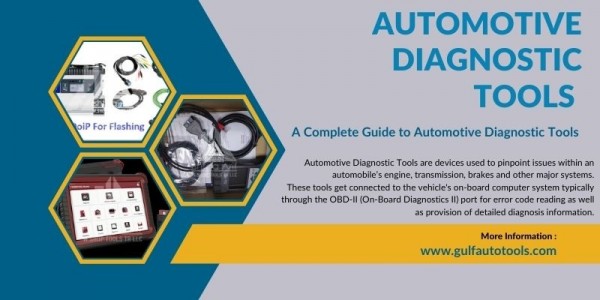
Have a Question? :
+971 55 7841839
Login / Register

16 Aug, 2024, 12:05 PM

With the advent of modern technology, vehicles today are a far cry from their early versions and they now come with highly technical systems and parts. Automotive diagnostic tools are the key to the maintenance and repair of these sophisticated machines.
They give mechanics and car owners the skill to identify malfunctions as well as find solutions to them with expediency, which in turn guarantees that cars run smoothly and safely.
What Are Automotive Diagnostic Tools?
Automotive Diagnostic Tools are devices used to pinpoint issues within an automobile’s engine, transmission, brakes and other major systems.
These tools get connected to the vehicle's on-board computer system typically through the OBD-II (On-Board Diagnostics II) port for error code reading as well as provision of detailed diagnosis information.
Types Of Automotive Diagnostic Tools
Automotive diagnostic tools which perform various functions are designed in different ways:
● OBD-II Scanners: They are among the basic scanners which can diagnose your vehicle’s OBD-II system. They can scan, read or clear all DTCs in different systems of your car such as engine and transmission or even anti-lock brake system etc.
● Code Readers: These are simpler than OBD-II scanners in operation since they just retrieve or erase DTCs yet do not provide any further information besides normal trouble codes. Multimeters: They play a key role in diagnosing electrical issues on a vehicle by measuring electrical values like voltage, current and resistance in its circuits.
● Oscilloscopes: Graphically display electrical signals for advanced diagnostic tools which help technicians to analyze the performance of vehicle components in real time.
Advantages of Employing Automotive Diagnostic Instruments
Automotive diagnostic tools offer numerous advantages:
● Efficiency and Speed: These tools will help in identifying the problem faster thereby cutting down the time required to diagnose and resolve it. This goes hand in hand with reduced costs in terms of finances that the mechanics and the car owners will have to incur.
● Accurate Diagnoses: Diagnostic tools are of great aid especially when repairing a vehicle since they give accurate details of the vehicle’s systems thus reducing the cases of misdiagnosis and unnecessary repair work.
● Preventative Maintenance: Using the diagnostic tools frequently will assist in identifying problems that could be developing into greater problems hence assisting in avoiding avoidable dates for repair work on the vehicle prolonging its operational span.
The Future of Automotive Diagnostic Tools
The future of automotive diagnostic tools is promising, and with the development of new technologies, it becomes apparent that the future of such tools is only set to continually improve. Computing advances like wireless diagnostics, mobile integration, ubiquitous access and the increased use of artificial intelligence are enhancing the effectiveness of these tools.
Conclusion
Automotive diagnostic tools are among the vital tools that must be used when fixing modern cars. The performance parameters give out important information on a car, making diagnosis and possible rectification smooth, fast and cheap.
Ensuring that these tools are understood and applied can enhance both the performance and durability of a car for anyone. Over time, as technology is a continuous process, the functionality of such diagnostic tools will only advance and bring in more changes in the automobile industry.